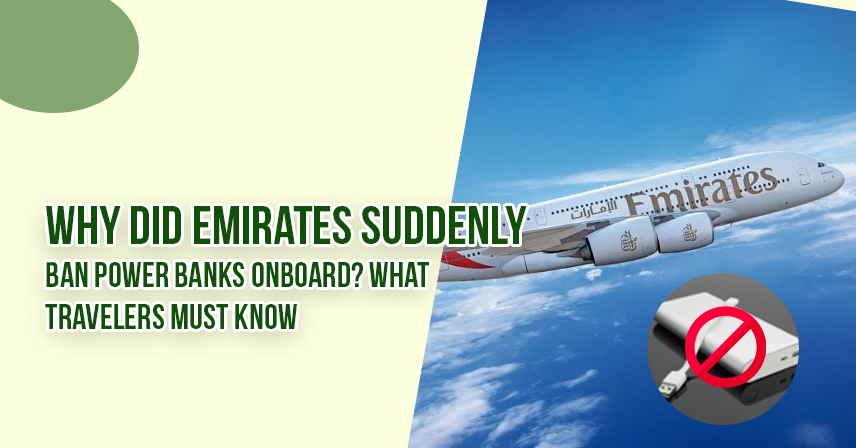Emirates power bank ban news announced which is effective from October 1, 2025 for the safety concern across the aviation industry according to a review that classified the increased incidents due to usage of lithium battery onboard. A power bank is a portable and rechargeable device that is designed to provide power to various electronic devices like tablets, smartphones, cameras, and laptops. Emirates passengers are still allowed to carry one power bank onboard subject to the certain conditions.
The power bank may not be used in the cabin, neither to charge any electronic device nor to be charged itself through the power source of the aircraft as said in the Emirates cabin rules. The power bank must be stored in the seat pocket, under the seat in front of you, or in the overhead compartments. The new rules are designed to make traveling safer by reducing the risks associated with lithium-ion batteries.
Emirates New Rules For Power Bank Include:
Emirates has announced a ban on using power banks during flights starting October 1, 2025. Emirates customers may take one power bank that must be under 100 watt-hours.
- Power banks may not be used to charge any personal devices onboard.
- Charging a power bank through the plane’s power supply is not permitted.
- All kinds of power banks are acceptable for transport, which must have the capacity rating information available as per the Emirates power bank ban news.
- Similarly, the power banks may not be placed in the overhead bin storage onboard the aircraft.
- However, power banks are not allowed to be carried in checked baggage.
Know Why Emirates Makes These Changes?
- Emirates has banned the use of “any” power banks on board its flights beginning from October 1, 2025, after safety issues following a power bank was connected to a fire on plane.
- As per the reports, Emirates is taking a firm and proactive stance to mitigate risk when it comes to carrying a power bank on the plane.
- In recent years, more and more people have started using power banks (portable chargers) that let you recharge your devices when you are on the move.
- However, this rise in popularity has also led to a growing number of safety incidents involving the batteries used in these power banks during flights.
- Most power banks use lithium-ion/lithium-polymer batteries which consist of lithium particles suspended in a special liquid according to the Emirates power bank ban rules.
- When you charge or use a power bank, these lithium particles move back and forth between two parts of the battery.
- But if a battery is overcharged or damaged, it can overheat in a dangerous way, a situation known as ‘thermal runaway.’
- This means the battery gets so hot that it can catch fire, explode, or release harmful gases. Such problems can pose serious risks, especially on airplanes.
- It is important for users to handle power banks carefully to help prevent these incidents.
- Most phones and sophisticated lithium battery-powered devices have an internal trickle system that adds current to prevent overcharging.
- But many basic power banks may not carry this safeguard, which increases the risk.
- Similarly, all power banks are subject to the new regulations onboard by Emirates.
The Evolution Of Power Bank Regulations
Power banks have become the must-carry item for passengers, especially during travel. They help to keep device charges during the journey especially for long flights. However, the rise in popularity has brought attention to the safety concerns associated with the lithium battery technologies used in these devices. Power banks are permitted in cabin baggage only and not in checked-in baggage.
The incidents involving the malfunctioning of lithium batteries have prompted the regulatory bodies, including those in the aviation industry to tighten the safety measures as per the Emirates Airlines lithium battery policy. Emirates has initiated the regulations that necessitate close monitoring and restrictions on the carriage and utilization of such batteries onboard.
Also checkout: Emirates Airlines Refund Policy
The Future Of Power Bank Usage In Air Travel
- Emirates rules about using electronic devices are likely to change as air travel becomes more popular.
- Airlines are expected to improve safety measures and educate passengers on how to safely use power banks and similar gadgets during flights.
- This could lead to stricter rules about what devices passengers can use while in the air.
- They could also affect travel trends, especially in places where many tourists fly while these new regulations are aimed at keeping everyone safe.
- Tougher luggage rules might change how travelers plan their trips when it comes to using technology while exploring new places.
- Carrying electronic devices could become more complicated that require travelers to be more aware of the rules and make sure they follow them.
Emirates Rules Of Power Bank 100Wh Limit: What Does This Mean?
Under the Emirates power bank ban regulations, the 100-watt-hour limit is a key threshold in the baggage policy. Devices with the capacity details that show a rating under 100Wh clearly are considered eligible for carry-on and subject to the other restrictions. Similarly, passengers must verify that the rating label on the power bank and be prepared to show it if requested by the crew.
Emirates may ask travelers to provide additional information to verify compliance if the rating is not marked clearly. This limit encourages travellers to plan ahead and avoid bringing large power banks. It may be crucial to consolidate the power banks that rely on the other charging options for flyers who carry various devices as per the Emirates safety rules. Additionally, Emirates aims to balance the convenience of the passengers with safety by enforcing the clear limit of 100Wh.
In Conclusion!
Emirates has introduced new rules about power banks to ensure safety in air travel, which shows their commitment to keeping passengers safe. Emirates power bank ban regulations are part of a larger effort in the airline industry to make flying safer and more responsible. They will need to be aware of these new safety measures as travelers get ready to embark on their adventures.
For those interested in staying updated on travel trends, contact Toursntravelpro at Call Us : +1-866-679-5070 as we are a great resource for the latest news and developments in the tourism industry. We also help you to improve the overall travel experience.
Frequently Asked Questions
Yes! You can bring a new power bank when flying with Emirates Airlines, but you can not use it throughout the flight to charge any of your devices. Your power bank must be under 100 watt-hours, have clearly visible capacity information, and be stored in your seat pocket. Power banks are also not permitted in the checked baggage.
No airline has banned power banks; instead, they have tightened rules that allow power banks under 100Wh in the carry-on baggage. It needs the airline’s approval for those between 100-160Wh and prohibits any power bank over 160Wh. Emirates has implemented a specific ban on their flights, while most airlines still allow them with certain restrictions, such as keeping them in plain sight when in use and making sure they are not damaged.
Yes! You can bring a 20,000 mAh power bank on a flight but it must be in your carry-on luggage and cannot be checked. A 20,000 mAh power bank is well under 100 the 100-watt-hour limit set by the TSA. Make sure that the power bank has its capacity marked on it for safety, and it protects its ports from short-circuiting. Keep it in your carry-on, not in the checked baggage.
A 30,000mAh power bank is allowed in carry-on baggage but requires airline approval. It usually falls between 100Wh and 160Wh. You must have prior approval from the airline for power banks in this range, and they are forbidden in checked baggage due to the risk of fire.
Emirates passengers can carry one power bank with a capacity of under 100 watt-hours, but its usage for device charging is restricted on the plane. The power bank itself should be stored in the overhead bin or under the seat in front of you. Similarly, the capacity of the power bank should be clearly marked on the device.












